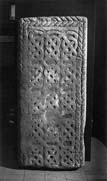Select a site alphabetically from the choices shown in the box below. Alternatively, browse sculptural examples using the Forward/Back buttons.
Chapters for this volume, along with copies of original in-text images, are available here.
Object type: Incomplete grave-cover [1]
Measurements: L. 112 cm (44 in) W. 50 cm (20 in) D. 16 cm (6.25 in)
Stone type: Oolitic limestone, including some ooliths of 0.6 to 0.8 mm diameter apparently in a fine-grained matrix, and some large (20 mm or more) recrystallised shell fragments. Lower Lincolnshire Limestone probably from Lincoln vicinity, Inferior Oolite Group
Plate numbers in printed volume: Fig. 14; Ills. 301–3
Corpus volume reference: Vol 5 p. 233-234
(There may be more views or larger images available for this item. Click on the thumbnail image to view.)
An almost complete flat rectangular grave-cover of Lindsey type with no measurable taper decorated in low relief and only on the upper surface.
A (top): The border is defined by a twin cable moulding in a herringbone pattern and the central panel is occupied by three interconnecting lines of simple pattern F interlace, which produce a repetitive figure-of-eight pattern in five surviving rows. The figure-of-eight units measure 18 × 11.5 cm (7 × 4.5 in). The layout and spacing of the lines and rows is entirely regular, but towards the complete end the pattern terminates against a plain reserved area scalloped by the cross-joined strands. Despite its abraded surface, the decoration stands sharply as a squared U section against the flat cut-away background.
B and D (long): Undecorated, with a battered profile.
C (end): Undecorated.
E (end): Cut for reuse as threshold.
F (bottom): Roughly dressed.
This is one of the interlace covers of Lindsey type discussed in Chapter V. It is the most complete of the sub-group (a) distinguished by their double cable or herringbone border (Table 6). Since it was cut for the same reuse as the most complete example of sub-group (b) at Cammeringham (Ill. 81), its surviving length is similar: on both covers five rows of interlace remain. If, as assumed by Stocker's (1986a, fig. 53) reconstructions of the examples from Lincoln St Mark (nos. 3 and 4, Ills. 239, 241), only completion of the pattern and the border have been removed, then the Miningsby cover would have been about 120–130cm (48–51 in) in original length. For each additional row of the pattern about 20cm (7.75 in) would be added. Its width closely matches that of Lincoln St Mark 4 and probably Laceby 1 in its sub-group and Cammeringham 1, Lincoln St Mark 3 and Theddlethorpe St Helen 1 in sub-group (b). The creation of a reserved area at the end of the pattern, if a deliberate decorative device, finds a direct analogy in Lincoln St Mark 4 (Ill. 241) except for the absence of any sign of comparable incised decoration at Miningsby. Since the norm on these covers is for the herringbone to point to the foot end, this reserved area lay at the head of both covers. In quality of stone, regularity of layout and fineness of finish, this cover is typical of the sub-group.
The drawing in the Ross manuscript (Ill. 303) is inaccurate in showing only four rather than five rows of figure-of-eight pattern. In other respects, however, including the way the complete end of the pattern is finished and the directions of the double-cabled border, it is well-observed.



